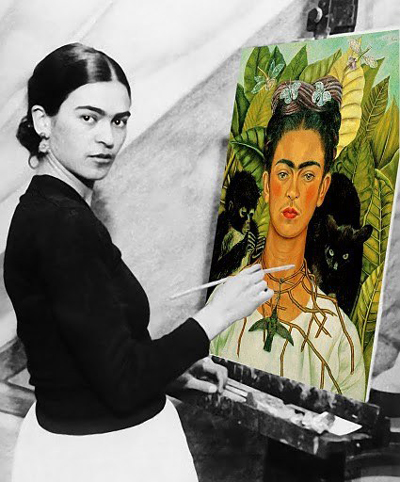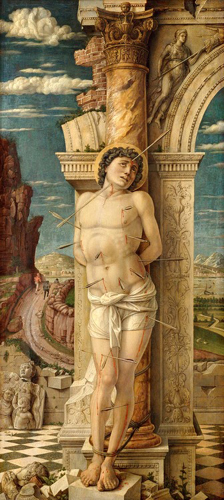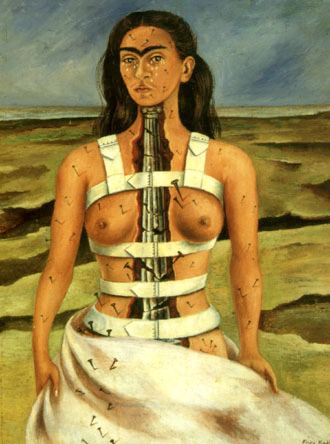“I recommend her to you, not as a husband but as an enthusiastic admirer of her work, acid and tender, hard as steel and delicate and fine as a butterfly’s wing, lovable as a beautiful smile, and as profound and cruel as the bitterness of life.” (Diego Rivera of Frida Kahlo)
Last Saturday I visited the Art Gallery of Ontario’s Frida & Diego exhibition: “Passion, Politics & Painting” in Toronto and finally had a chance to see the work of one of my favourite artists: Frida Kahlo!
I first glimpsed Kahlo’s work years ago in a modern art history class. I was so taken by several of her self-portraits, I wrote a paper on one. I loved the way she incorporated personal history, cultural mythology/iconography and haunting dream-like imagery into her paintings. Although she’s often compared to the Surrealists who painted dream-like worlds, Kahlo maintained she painted her reality. I was spellbound by the many painful self-portraits of the artist; her unhappiness exposed like an open wound for all to see* – her sadness over her husband Diego’s numerous affairs; the many miscarriages she suffered and the pain she endured from many operations due to chronic pain caused by a near-fatal accident in her youth. Far from being a bed-ridden soul, Kahlo led a tumultuous existence, one in which she carried out scandalous love affairs with both men and women and as a rebel rouser for the Marxist political cause in Mexico. Despite personal hardships, Kahlo used art to lift herself out of her misery and carved out prolific career for herself.
When I think of Frida Kahlo’s work, I’m reminded of the Roman Catholic saints I read about as a child. In these books, the saints appeared as tragic heroic figures often portrayed alongside the very weapons their enemies used to kill or torture them with: swords, fire, and arrows… in these haunting representations they stood angelic or defiant with eyes raised upward to heaven or downward in humility. I secretly longed to become one of them! Instead, decades later, I would find Frida K., their anti-thesis, and she would become my patron saint of art. Rather than offering up her life up to God, she fought for life and her own personal causes: art, politics and her beloved husband, also a renowned painter.
It was incredible to see the original work “The Broken Column” I’d written about years ago. Here Kahlo depicts herself in a Christ/martyr-like manner. She stands in a desolate landscape, her body flayed open to reveal a broken architectural column which replaces her spine. Nails pierce her body and the tiniest of tears trickle down her face. A tortured soul, she boldly confronts the viewer as if to say “all this… and still I go on!” Among other things, the painting reflects the agony inflicted upon her body by many surgeries – 32 over her life span which left her unable to carry a child to full term. There are a number of images depicting Kahlo in the hospital after suffering a miscarriage; she doesn’t shrink from making reference to this incident in drawings or paintings rendering bodily organs, precious fetus and blood in the finest detail and jewel-like colour. A piece I never expected to see in the exhibit was one of the plaster corsets Kahlo wore to help support her body. On this one she had painted the Communist sickle and hammer symbol across the chest and a fetus on the belly. Seeing it in person struck an emotional chord in me. A kind of spiritual armor, this relic is evidence that even in the lowest physical and emotional state, expressing herself was vital. I draw such strength from her contradictory visual mix of vulnerability and power. To see the many versions of Frida persevering life’s various misfortunes one beautiful painting after the next, ignites my admiration for her and makes me wonder if perhaps art and the creative life can save us from the madness life doles out.
Seeing the works of my artist idols never fails to make me reflect upon my own strategies as an artist. Kahlo’s work made me realize that it’s okay to express my personal pain, even publicly through my art. I think of her courage and audacity in depicting paintings of her fetus at the time when such subject matter was taboo. She was painting and confronting issues which would have never been mentioned in polite society during her day! … such an event a woman or a couple would have endured in silence, in privacy of their own home… if they even acknowledged it at all. I realize not everyone can relate to work like this. But for those of you who do, I hope you’ll draw on the same sense of strength I draw from Kahlo’s work. While some put their most idealistic faces forward for the artist portrait, Frida Kahlo simultaneously reveals life’s breathtaking beauty and ugliness … she stands with her painter’s “brush of anguish”** in hand refusing to sweep the emotional debris of life under the carpet… and I love her for that!
Regardless of whether the work is happy, sad or somewhere in between, finding kindred artists can help situate where we’d like our work to go as budding or emerging artists and creatives. Who is/are your role model(s)? Whose work stirs your soul? I would love to know… I hope someone will share theirs with me!
* Note 1: Kahlo didn’t just focus on the pain in her life; there are many other paintings that reveal her other moods and interests. She was known to have a great sense of humour as well.
** Note 2: The term “brush of anguish” is taken from the title of Martha Zamora’s book about Frida Kahlo which I highly recommend.
Other Related Links:
Frida Kahlo Fans Website





Great posts as usual Michelle! I’m so excited for the year ahead for you and for me as “artiste” in training. I really enjoyed this piece on Frieda Kahlo. I had no idea that she was such a complex and courageous woman. I attending a lecture and exhibit today on the artist William H. Johnson, who led an incredibly fulfilling life for his first 47 years, but was sadly derailed by dementia and illness for his remaining years. I think the juxtaposition narrative of your post today and what I learned today about Mr. Johnson, has encouraged me to live life to its fullest.
Happy New Year!!
Gloria
Hi Gloria! Thanks so much for your kind wishes and for taking the time to review my Frida Kahlo blog. I’m glad you enjoyed it and learned new things about Kahlo. I’ve never heard of artist William H. Johnson! I googled him and learned of his beautiful but tragic life history and saw some of his amazing work. His art and life share some similarities with the spirit of Frida’s. His graphic, expressionist style reminded me of Vincent Van Gogh’s (their tragic endings such an eerie coincidence, too). I love that Johnson portrayed so much African-American history in his work: soldiers going off to war, people tending their farms, folks going to church or dancing the jitterbug!… as well as other unhappy social and political mistreatment Black people suffered in his life time. Reviewing his work was like flipping through the pages of a history book! His images are minimalist yet also emotional riveting. I saw one piece “Farm Couple” which echoed elements Andrew Wyeth’s “American Gothic” — what a brilliant visual strategy! It’s true as you say by taking a look at the lives of these artists and their work, we realize how lucky we are not to be suffering in the same way and that we’re able to live our life to the fullest. To that end, I hope the example of Johnson and Kahlo will inspire and bring out the incredible “artiste” in you!!! I look forward to seeing your experiments when you’re ready to share them! Thanks for illuminating the work of William H. Johnson! Warmest wishes, Michelle